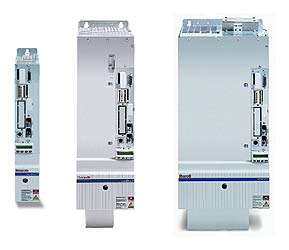
Industrial motion control systems start with a servo motor, a motor which can be directed to take very specific actions which in turn make the machines they control perform very specific actions. Servo motors are in communication with amplifiers, or drives, which send a specific amount of power to the motor to cause the machine to take the action.
A drive which provides too much power for the movement required could wear a servo motor out before its time. A drive that provided too little force could keep the servo motor from doing its job. This means that it’s not as simple as just picking the highest power drive you can afford.
Sometimes a servo motor and drive may be integrated. The Rexroth Indradrive Mi KSM, for example, includes both a servo motor and a servo drive amplifier in a simple compact unit. The IndraDrive Mi family includes more drive options, including cabinet-free drives and a decentralized network module.
In most cases, though, the combination of drive and motor must be carefully chosen to meet the needs of your specific application. Read on to learn about some of the issues you should take into account when deciding among all the Rexroth electric serv drives.
Converter or inverter?
The first choice for drives is between the converter, which includes its own power source, and the inverter. For Rexroth, these are the HCS and HMS drives, respectively. Inverters can be added to the converters to customize a system for a multi-axis application. The converter of the first axis supplies the power for the inverters for the other axes. This is a cost-effective solution.
In every case, the chosen power supply has to have enough power to support all the other drives and motors.
Because the amount of power needed may depend on a number of factors and may vary considerably from one project to another, Rexroth makes drives at many different power levels. The wide power range and small increments along that range make it easy to choose just the right drive.
Motor compatibility
Many Rexroth drives are designed to support all Rexroth servo motors, and often they’ll work with third party motors as well. In such cases, some decisions about the motor can be made separately from decisions about the drive. For example, if you want to use a servo motor in a potentially explosive situation, you’ll need to consider the Rexroth MKE motor range. All IndraDrive dries will work with MKE motors, so it’s a matter of choosing the right size of drive.
Check the manual for the drive you’re considering to determine which kind of motor it will work with.
Time depth
In addition to the current IndraDrive and IndraDrive Mi options, Rexroth also has legacy drives including DKR, DKS, HDS, and RAC, among others. If you already have legacy drives in service, and you’re thinking about using them with latest generation motors or adding modules from other Rexroth families, you usually can. New Belgium brewery provides an example of a facility that was able to integrate new and legacy machinery from many different factories.
Rexroth supports legacy components for an unusually long time. The age of your chosen drive may not be a limiting factor for choosing a servo drive. Legacy manuals may not help you determine which drives will work with which motors. After all, those manuals couldn’t predict the future.
If you’re not sure which drive to choose, give us a call. We specialize in Rexroth electric motion control, and we’ll be happy to answer your questions.
